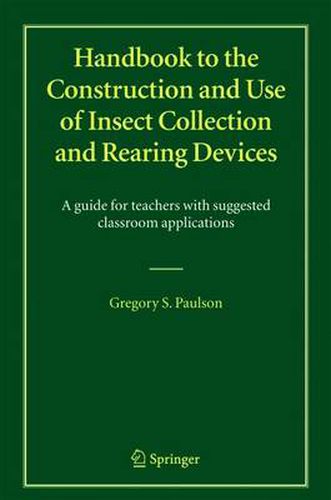Readings Newsletter
Become a Readings Member to make your shopping experience even easier.
Sign in or sign up for free!
You’re not far away from qualifying for FREE standard shipping within Australia
You’ve qualified for FREE standard shipping within Australia
The cart is loading…






This title is printed to order. This book may have been self-published. If so, we cannot guarantee the quality of the content. In the main most books will have gone through the editing process however some may not. We therefore suggest that you be aware of this before ordering this book. If in doubt check either the author or publisher’s details as we are unable to accept any returns unless they are faulty. Please contact us if you have any questions.
Insects are great classroom study organisms. They are easy to collect and raise and have a fascinating array of life histories. Because they are small and have tremendous reproductive capacity ecological studies of dispersion, predation, parasitism and reproduction can be studied in compressed timeframes and small areas relative to similar studies of larger organisms. Insects are also important bioindicators of the health of ecosystems. In a small space and with very little cost colonies of insects can be raised in classrooms for use in behavioral and physiological studies. The purpose of this book is to explain how to build and use insect collecting and rearing devices and through explanations of the various techniques stimulate educators to explore the study of insects in their classrooms. Insects are often given little consideration with regard to humane handling practices. Please remember that insects are living creatures and, as such, are entitled to the same treatment as other living creatures. Teachers should remember that students look to them for clues to the proper way of behaving in new situations. When collecting and working in the field educators should teach students to respect the environment. Do not collect more organisms than needed, treat all of the organisms you collect with care, and try not to leave signs of your presence in an area by returning rocks, logs, etc. to their original locations. If you must kill animals you’ve collected, do so quickly and humanely.
$9.00 standard shipping within Australia
FREE standard shipping within Australia for orders over $100.00
Express & International shipping calculated at checkout
This title is printed to order. This book may have been self-published. If so, we cannot guarantee the quality of the content. In the main most books will have gone through the editing process however some may not. We therefore suggest that you be aware of this before ordering this book. If in doubt check either the author or publisher’s details as we are unable to accept any returns unless they are faulty. Please contact us if you have any questions.
Insects are great classroom study organisms. They are easy to collect and raise and have a fascinating array of life histories. Because they are small and have tremendous reproductive capacity ecological studies of dispersion, predation, parasitism and reproduction can be studied in compressed timeframes and small areas relative to similar studies of larger organisms. Insects are also important bioindicators of the health of ecosystems. In a small space and with very little cost colonies of insects can be raised in classrooms for use in behavioral and physiological studies. The purpose of this book is to explain how to build and use insect collecting and rearing devices and through explanations of the various techniques stimulate educators to explore the study of insects in their classrooms. Insects are often given little consideration with regard to humane handling practices. Please remember that insects are living creatures and, as such, are entitled to the same treatment as other living creatures. Teachers should remember that students look to them for clues to the proper way of behaving in new situations. When collecting and working in the field educators should teach students to respect the environment. Do not collect more organisms than needed, treat all of the organisms you collect with care, and try not to leave signs of your presence in an area by returning rocks, logs, etc. to their original locations. If you must kill animals you’ve collected, do so quickly and humanely.